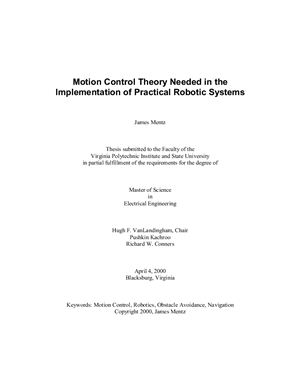Two areas of expertise required in the production of industrial and
commercial
robotics are motor control and obstacle navigation algorithms. This is especially true in
the field of autonomous robotic vehicles, and this application will be the focus of this
work. This work is divided into two parts. Part I describes the motor types and feedback
devices available and the appropriate choice for a given robotics application. This is
followed by a description of the control strategies available and appropriate for a variety
of situations. Part II describes the vision hardware and navigation software necessary for
an autonomous robotic vehicle. The conclusion discusses how the two parts are coming
together in the emerging field of electric smart car technology. The content is aimed at the robotic vehicle designer. Both parts present a
contribution to the field but also survey the required background material for a researcher
to enter into development. The material has been made succinct and graphical wherever
appropriate.
robotics are motor control and obstacle navigation algorithms. This is especially true in
the field of autonomous robotic vehicles, and this application will be the focus of this
work. This work is divided into two parts. Part I describes the motor types and feedback
devices available and the appropriate choice for a given robotics application. This is
followed by a description of the control strategies available and appropriate for a variety
of situations. Part II describes the vision hardware and navigation software necessary for
an autonomous robotic vehicle. The conclusion discusses how the two parts are coming
together in the emerging field of electric smart car technology. The content is aimed at the robotic vehicle designer. Both parts present a
contribution to the field but also survey the required background material for a researcher
to enter into development. The material has been made succinct and graphical wherever
appropriate.

